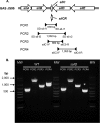Molecular epidemiology of sil locus in clinical Streptococcus pyogenes strains
- PMID: 24671796
- PMCID: PMC4042805
- DOI: 10.1128/JCM.00290-14
Molecular epidemiology of sil locus in clinical Streptococcus pyogenes strains
Abstract
Streptococcus pyogenes (group A Streptococcus [GAS]) causes a wide variety of diseases, ranging from mild noninvasive to severe invasive infections. Mutations in regulatory components have been implicated in the switch from colonization to invasive phenotypes. The inactivation of the sil locus, composed of six genes encoding a quorum-sensing complex, gives rise to a highly invasive strain. However, studies conducted on limited collections of GAS strains suggested that sil prevalence is around 15%; furthermore, whereas a correlation between the presence of sil and the genetic background was suggested, no link between the presence of a functional sil locus and the invasive status was assessed. We established a collection of 637 nonredundant strains covering all emm genotypes present in France and of known clinical history; 68%, 22%, and 10% were from invasive infections, noninvasive infections, and asymptomatic carriage, respectively. Among the 637 strains, 206 were sil positive. The prevalence of the sil locus varied according to the emm genotype, being present in >85% of the emm4, emm18, emm32, emm60, emm87, and emm90 strains and absent from all emm1, emm28, and emm89 strains. A random selection based on 2009 French epidemiological data indicated that 16% of GAS strains are sil positive. Moreover, due to mutations leading to truncated proteins, only 9% of GAS strains harbor a predicted functional sil system. No correlation was observed between the presence or absence of a functional sil locus and the strain invasiveness status.
Copyright © 2014, American Society for Microbiology. All Rights Reserved.
Figures



References
Publication types
MeSH terms
Substances
LinkOut - more resources
Full Text Sources
Other Literature Sources
Medical

